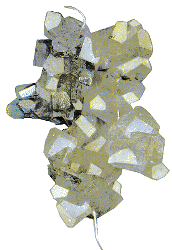Links:
Laryngitis Materials:
All work is due on April 12!
Class Schedule:
- Tues 4/5: class
- Thurs 4/7: no class
More about igneous rocks
Outline
- Introduction to today's lecture
- How do we know the Earth's age?
- The Earth's internal structure
- Rocks and Minerals
- Three types of rock
- More about igneous rocks
- Powerpoint
lecture notes
- Outline
- Basic Concepts
- Geologic Time1
- Geologic Time2
- An Illustration of Geologic Time
- Geologic Time Simplified -We covered up to this point in class-
- How do we know the Earth's age?
- The Earth's internal structure
- Rocks and Minerals
- Three types of Rock
- Igneous Rock
In this section, I will teach you the names of four rocks and how to identify them. I've chosen these particular four rocks because they will help illustrate two important properties of igneoud rocks: the 'grain' size, or size of the crystals, and the chemical make up of the rocks.
Crystal Size: Intrusive and Extrusive Rocks
Igneous rocks form from molten rock. If this molten rock is deep underground,
we call it magma. If the molten rock is on the
surface, then we call it lava. Why does it matter?
There are a couple of reasons. The most important one for our perspective
is the amount of time that it takes for the rock to cool. Lava, on the
surface, might cool and solidify within hours. Magma, deep underground,
might take thousands of years to cool and solidify. When rocks take a
long time to cool, their minerals have more of a chance to organize and
form crystals.
 Think
of the rock candy (see picture to the left) that you may have made as
a kid: you dissolve lots of sugar in super hot water, put it in a petri
dish, and put a string in the solution. If you let the dish sit there
quietly, undisturbed, then large crystals will start to form. If you were
an impatient kid like me, then you would keep fussing with the dish, trying
to see if any crystals had formed yet. So the crystals never had time
to form.
Think
of the rock candy (see picture to the left) that you may have made as
a kid: you dissolve lots of sugar in super hot water, put it in a petri
dish, and put a string in the solution. If you let the dish sit there
quietly, undisturbed, then large crystals will start to form. If you were
an impatient kid like me, then you would keep fussing with the dish, trying
to see if any crystals had formed yet. So the crystals never had time
to form.
Igneous rocks are the same way: the longer they take to cool, the larger their 'grain', or crystal size. Intrusive rocks, which form deep underground from magma, typically have large mineral crystals. Extrusive rocks, which form from lava on the Earth's surface, typically have no visible crystals in them. They look like one big, homogeneous mass, with no visible crystals.
Rock Chemistry: Mafic and Felsic Rocks
Igneous rocks are made from a mixture of minerals. Mafic rocks tend to have lots of minerals that are high in Magnesium and Iron. Felsic rocks tend to have a lot of minerals such as Feldspar that are high in Silica (FELSIC comes from FELdspar and SIlica). The Mantle and Oceanic crust are made up of the dense, dark-colored mafic minerals, while Continental crust tends to have more of the light-colored, less-dense Felsic minerals. If you were to sit a very mafic rock next to a very felsic rock, then the mafic rock would most likely be darker and denser.
Here's a summary:
| Intrusive |
Extrusive |
Mafic |
Felsic |
|
|
|
|
|
Now let's combine these two ideas:
| Extrusive | Intrusive | |
| Mafic | Dark color, no crystals: Basalt | Dark color, large crystals: Gabbro |
| Felsic | Light color, no crystals: Rhyolite | Light color, large crystals: Granite |
I'll show you examples of these rocks when I see you again. The book also has some nice pictures. In the meantime, try to learn these four names. Basalt and Granite are the two most important ones though.
I'll see you soon!
-Marty